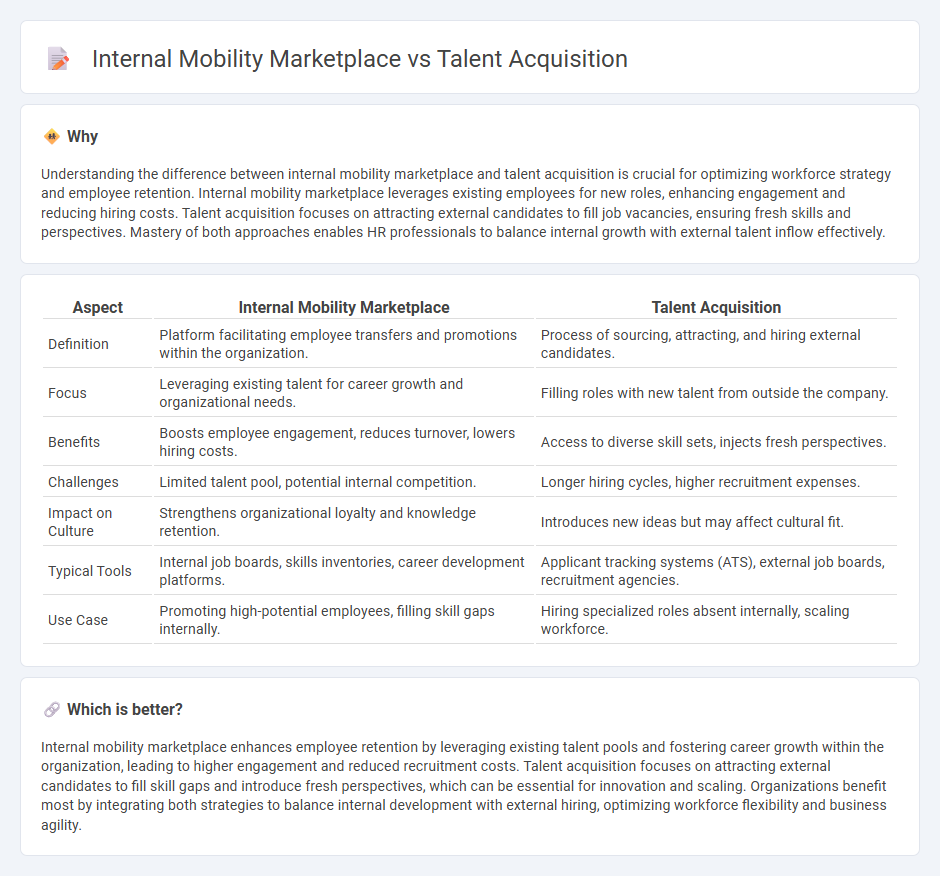
Internal mobility marketplaces prioritize leveraging existing employee skills and promoting career growth within the organization, enhancing retention and reducing recruitment costs. Talent acquisition focuses on attracting and hiring external candidates to fill job vacancies, expanding the talent pool with fresh perspectives. Explore how integrating both strategies can optimize workforce planning and drive organizational success.
Why it is important
Understanding the difference between internal mobility marketplace and talent acquisition is crucial for optimizing workforce strategy and employee retention. Internal mobility marketplace leverages existing employees for new roles, enhancing engagement and reducing hiring costs. Talent acquisition focuses on attracting external candidates to fill job vacancies, ensuring fresh skills and perspectives. Mastery of both approaches enables HR professionals to balance internal growth with external talent inflow effectively.
Comparison Table
| Aspect | Internal Mobility Marketplace | Talent Acquisition |
|---|---|---|
| Definition | Platform facilitating employee transfers and promotions within the organization. | Process of sourcing, attracting, and hiring external candidates. |
| Focus | Leveraging existing talent for career growth and organizational needs. | Filling roles with new talent from outside the company. |
| Benefits | Boosts employee engagement, reduces turnover, lowers hiring costs. | Access to diverse skill sets, injects fresh perspectives. |
| Challenges | Limited talent pool, potential internal competition. | Longer hiring cycles, higher recruitment expenses. |
| Impact on Culture | Strengthens organizational loyalty and knowledge retention. | Introduces new ideas but may affect cultural fit. |
| Typical Tools | Internal job boards, skills inventories, career development platforms. | Applicant tracking systems (ATS), external job boards, recruitment agencies. |
| Use Case | Promoting high-potential employees, filling skill gaps internally. | Hiring specialized roles absent internally, scaling workforce. |
Which is better?
Internal mobility marketplace enhances employee retention by leveraging existing talent pools and fostering career growth within the organization, leading to higher engagement and reduced recruitment costs. Talent acquisition focuses on attracting external candidates to fill skill gaps and introduce fresh perspectives, which can be essential for innovation and scaling. Organizations benefit most by integrating both strategies to balance internal development with external hiring, optimizing workforce flexibility and business agility.
Connection
Internal mobility marketplaces enhance talent acquisition by providing companies with a dynamic platform to identify and redeploy internal candidates efficiently, reducing external hiring costs and time-to-fill positions. Leveraging data analytics and AI-driven talent matching, these marketplaces improve employee retention by aligning career development opportunities with organizational needs. This integration fosters a strategic workforce planning approach, optimizing talent utilization and supporting continuous skill development within the organization.
Key Terms
**Talent Acquisition:**
Talent acquisition centers on sourcing, attracting, and recruiting external candidates to meet organizational hiring needs, leveraging tools like applicant tracking systems and employer branding strategies. It emphasizes building a diverse talent pipeline and optimizing recruitment processes to ensure high-quality hires aligned with business goals. Explore how advanced talent acquisition techniques can transform your workforce by learning more.
Sourcing
Talent acquisition leverages external candidate sourcing through job boards, social media, and recruitment agencies to fill open roles efficiently. Internal mobility marketplaces prioritize identifying and redeploying existing employees by matching skills and career aspirations to internal job openings, enhancing retention and employee engagement. Explore how integrating both strategies optimizes workforce sourcing and talent development.
Recruitment
Talent acquisition strategies emphasize sourcing external candidates to fill open positions, leveraging tools such as applicant tracking systems and job boards to identify top talent. Conversely, an internal mobility marketplace promotes recruitment within the organization by matching employees to new roles based on skills and career aspirations, enhancing retention and reducing time-to-hire. Explore how optimizing recruitment through these approaches can transform workforce agility and business outcomes.
Source and External Links
Talent Acquisition: The Ultimate Guide - Talent acquisition is the process of identifying, attracting, selecting, and retaining highly qualified people, using strategies like Build (in-house competency development), Buy (hiring experienced talent), Borrow, and Bridge to meet organizational goals.
What is Talent Acquisition? Tips & FAQs - Talent acquisition involves aligning recruitment strategy across departments, employer branding, candidate lifecycle management, and retention efforts to recruit and keep skilled workers strategically for long-term organizational success.
Talent Acquisition | How Does it Work? (Explained) - Talent acquisition is a strategic six-step process including networking, recruiting, interviewing, and onboarding, often supported by technology and tailored strategies like bulk hiring or senior leadership recruitment.
 dowidth.com
dowidth.com